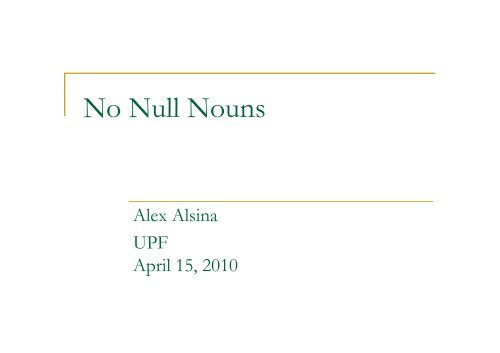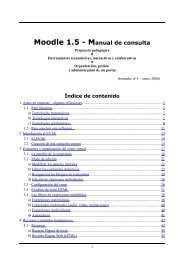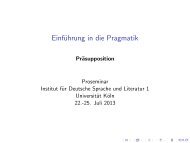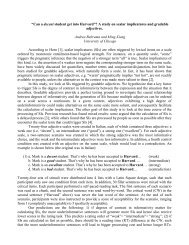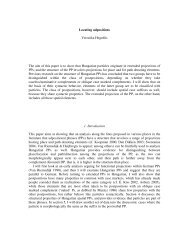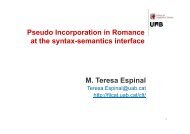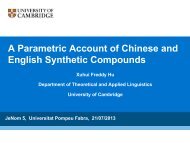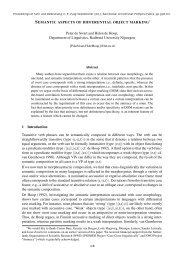No Null Nouns - corpora@parles.upf
No Null Nouns - corpora@parles.upf
No Null Nouns - corpora@parles.upf
You also want an ePaper? Increase the reach of your titles
YUMPU automatically turns print PDFs into web optimized ePapers that Google loves.
<strong>No</strong> <strong>Null</strong> <strong>No</strong>uns<br />
Alex Alsina<br />
UPF<br />
April 15, 2010
Aim of the talk<br />
To argue that apparently headless NPs are<br />
really headless.<br />
Examples:<br />
(1) a. M’agrada més aquest llibre antic amb tapes de<br />
cuiro.<br />
b. M’agrada més aquest antic amb tapes de cuiro.<br />
c. M’agrada més aquest amb tapes de cuiro.<br />
d. M’agrada més aquest antic.<br />
e. M’agrada més aquest.
Aim of the talk<br />
Structure of a headed NP:<br />
DP<br />
D′<br />
D NP<br />
N′ AP<br />
N A<br />
aquest llibre antic
Alternatives to choose from<br />
A. Structure of an NP<br />
with an empty head:<br />
DP<br />
D′<br />
D NP<br />
N′ AP<br />
N A<br />
aquest ∅ antic<br />
B. Structure of an NP<br />
without a head:<br />
DP<br />
D′<br />
D NP<br />
AP<br />
A<br />
aquest antic
Existing work<br />
The majority position is in favor of alternative A:<br />
Bosque 1989, Bosque i Gutiérrez-Rexach 2009,<br />
Brucart 2002, Brucart i Rigau 2002, Wheeler<br />
1991, among others.<br />
At this point I can’t cite any work explicitly<br />
assuming alternative B, although it is the natural<br />
assumption in analyses within LFG, HPSG, and<br />
other frameworks that factor grammatical<br />
information into different structures.
Structure of the talk<br />
Argument 1: positing empty nouns has the<br />
effect of making a potentially empirically<br />
contentful hypothesis unfalsifiable.<br />
Argument 2: two types of determiners: those<br />
that may, and those that may not, introduce<br />
headless NPs.<br />
Argument 3: prenominal adjectives: not<br />
possible in headless NPs.
Argument 1<br />
The empty noun reduces a hypothesis/claim to<br />
unfalsifiability.<br />
The claim that every XP is the projection of an<br />
X 0 (the projection claim) is a strong claim (a<br />
falsifiable claim) provided an X 0 is always a<br />
word—a lexical item with a phonological<br />
representation and a syntactic/semantic<br />
representation.<br />
If we have evidence that some string of words is<br />
an XP, we predict that it should include a word of<br />
category X in the right position.
Argument 1<br />
What counts as a counterexample to this claim?<br />
Eg: a phrase that behaves in all respects like a<br />
PP but does not include a preposition.<br />
Headless NPs are exactly this case.<br />
They are counterexamples to the projection<br />
claim.<br />
Two responses: (a) keep the claim but make it<br />
untestable, (b) abandon the claim.<br />
The majority position has been (a): we allow<br />
empty Ns so that headless NPs are no longer<br />
counterexamples to the projection claim.
Argument 1<br />
In fact, once we allow empty X 0 s, the projection<br />
claim is no longer a strong claim: it makes no<br />
predictions; it just tells us how to represent<br />
phrases.<br />
What’s the use of having untestable hypotheses<br />
(hypotheses that do not lead to testable<br />
predictions)?<br />
Better to abandon the projection claim: not all<br />
phrases have a head.<br />
This spares us from introducing a new<br />
hypothesis (the empty X 0 hypothesis) whose<br />
function is to make another hypothesis vacuous.
Argument 2: two types of Ds<br />
(2) a. Hem insistit en cada situació (compromesa) (que es<br />
va presentar).<br />
b.*Hem insistit en cada (compromesa) (que es va<br />
presentar).<br />
(3) a. Hem insistit en aquella situació (compromesa) (que<br />
es va presentar).<br />
b. Hem insistit en aquella (compromesa) (que es va<br />
presentar).
Argument 2: two types of Ds<br />
Weak determiners: cada, sengles, qualque, cert,<br />
mon, ton, son, llur, tot*, etc.<br />
Strong determiners: aquest, aquell, quin, quant, cap,<br />
un, algun, tant, molt, etc.<br />
If we allow empty nouns, we either cannot account<br />
for the difference in behavior or we have to restrict<br />
the null N in the appropriate position in relation to a<br />
strong determiner.<br />
The assumption that a strong D can license an<br />
empty N is ad hoc.<br />
* Tot, as in tota reclamació, tot document, not as<br />
in tots els llibres, tota l’estona, etc., where it is a<br />
predeterminer.
C-structure and f-structure<br />
An alternative that assumes syntactic information is<br />
factored into a categorial structure (c-structure) and<br />
a feature structure (f-structure) as parallel, copresent<br />
levels of representation.<br />
A string is grammatical if it satisfies the wellformedness<br />
conditions on both structures.<br />
Let’s start with the c-structure: a syntactic tree of the<br />
usual sort, satisfying<br />
Lexicalism: every X 0 dominates a fully formed word—a<br />
unit satisying morphological integrity and consisting<br />
at least of a phonological representation—of<br />
category X.
C-structure<br />
The usual inventory of categories: V, N, P, A, D, C,<br />
VP, NP, DP, etc.<br />
Functional categories ok, provided they comply with<br />
Lexicalism.<br />
X-bar Theory:<br />
X′′ YP X′ ( ′ )<br />
X′ X ( ′ ) ZP<br />
Economy of Expression: all c-structure nodes are<br />
optional and are only used if needed for semantic<br />
reasons or to satisfy well-formedness conditions.<br />
(Bresnan 2001)
C-structure of the noun phrase<br />
Words of category D in Cat.: el/la, cada, sengles,<br />
qualque, aquest, aquell, quin, cap, molt, etc.<br />
Spec of NP is reserved for SpecA (specificational<br />
adjectives): altre, dos, tres, primer, segon, últim,<br />
seu, nostre, etc.<br />
D always has an NP as its c-structure complement,<br />
if it has any complement.<br />
Spec of DP is reserved for predet. tot/s and adv.<br />
such as fins i tot, exactament, només, almenys, etc.:<br />
tots els llibres, només aquelles notes, etc.
Example c-structures<br />
DP<br />
D′<br />
D NP<br />
SpecA N′<br />
N PP<br />
aquell altre castell de cartes
Example c-structures<br />
DP<br />
D′<br />
D NP<br />
SpecA<br />
aquell altre<br />
DP<br />
D′<br />
D NP<br />
N′<br />
PP<br />
aquell de cartes<br />
DP<br />
D′<br />
D<br />
aquell
F-structure<br />
However, the principles given so far allow<br />
headless noun phrases with weak dets:<br />
cada *(proposta) nova<br />
cada *(paquet) que arriba<br />
cada *(estudiant) de doctorat<br />
*cada<br />
They are excluded by well-formedness<br />
conditions on the f-structure.<br />
F-structures: formally, attribute-value matrices<br />
that satisfy a uniqueness condition requiring<br />
each attribute to have a unique value.
F-structure<br />
Every word form has a vocabulary entry that<br />
specifies its c-structure information and its fstructure<br />
information.<br />
In forming the f-structure of a phrase:<br />
The f-structure of a phrasal category is that of its<br />
head;<br />
The f-structure of a functional category is that of its<br />
complement phrase.<br />
Thus, the f-structure of a DP is the unification of<br />
the f-structure of the head D and of the N head<br />
of the complement NP.
Sample vocabulary entries<br />
aquell: D SPEC [DEM +]<br />
NOMB sg<br />
GÈN masc<br />
aquella: D SPEC [DEM +]<br />
NOMB sg<br />
GÈN fem<br />
cadira: N PRED ‘cadira’<br />
NOMB sg<br />
GÈN fem<br />
calaix: N PRED ‘calaix‘<br />
NOMB sg<br />
GÈN masc
Sample det-noun sequences<br />
DP<br />
D′<br />
D NP<br />
N′<br />
N<br />
aquell calaix<br />
PRED ‘calaix‘<br />
SPEC [DEM +]<br />
NOMB sg<br />
GÈN masc
Sample det-noun sequences<br />
DP<br />
D′<br />
D NP<br />
N′<br />
N<br />
aquell cadira<br />
PRED ‘cadira‘<br />
SPEC [DEM +]<br />
NOMB sg<br />
GÈN masc<br />
fem
The two types of Ds<br />
Another condition that f-structures must satisfy:<br />
Completeness: every f-structure with a thematic<br />
role must have a PRED feature. (Bresnan 2001)<br />
Words of categories N, V, A generally have a<br />
PRED feature.<br />
Dets split into two groups: some don’t have this<br />
feature (the weak dets) and some have an<br />
optional [PRED ‘pro’] feature (strong dets).<br />
See vocabulary entries of a D of each type:
Example Ds of each kind<br />
aquell: D SPEC [DEM +]<br />
NOMB sg<br />
GÈN masc<br />
(PRED ‘pro’)<br />
cada: D SPEC [DISTR +]<br />
NOMB sg<br />
això: D SPEC [DEM +]<br />
NOMB sg<br />
GÈN masc<br />
PRED ‘pro’
<strong>No</strong>unless DPs of both kinds<br />
DP<br />
D′<br />
D<br />
aquell<br />
DP<br />
D′<br />
D<br />
cada<br />
SPEC [DEM +]<br />
NOMB sg<br />
GÈN masc<br />
PRED ‘pro’<br />
SPEC [DISTR +]<br />
NOMB sg<br />
Ill-formed fstructure:<br />
violates<br />
completeness
The role of null nouns<br />
Having empty categories would play no role<br />
in explaining the contrast between the two<br />
kinds of determiners.<br />
We would need some additional principles to<br />
tell us when the null noun is possible and<br />
when it is not.<br />
In this theory, null nouns are excluded by<br />
Economy of expression and Lexicalism.
Argument 3: prenominal adjectives<br />
Prenominal adjectives:<br />
must appear before a noun,<br />
follow SpecA, if there are any<br />
Examples: bon, mer/a, mal/a, presumpte/a,<br />
antic/ga (‘former’), trist/a (‘insufficient’).<br />
(4) a. un bon amic, *un amic bon, *aquest amic sí que<br />
era bon, *era un bon.<br />
b. una mera suposició, *una suposició mera, *aquesta<br />
suposició és mera, *era una mera.<br />
Strings not allowed by X-bar theory given.
Explaining prenominal As<br />
Two subtypes of A:<br />
A [+preN]. Ex: bon, mer, mal, etc.<br />
A [-preN]. Ex: dolent, bo, policial, etc.<br />
Many As are unspecified: belong to both<br />
subtypes.<br />
New c-structure rule (Sadler and Arnold 1994):<br />
N A N<br />
[+preN]<br />
Postnominal APs are projections of A [-preN].
Structures with prenominal As<br />
DP<br />
D′<br />
D NP<br />
N′<br />
N<br />
A N<br />
[+preN]<br />
un bon amic<br />
DP<br />
D′<br />
D NP<br />
SpecA N′<br />
N<br />
A N<br />
[+preN]<br />
els dos presumptes culpables
Excluding illicit structures<br />
Why are *un bon, *la mera illicit DPs?<br />
[+preN] adjectives must appear in the configuration<br />
[ N A [+preN] N ].<br />
By Lexicalism, both categories in this structure must<br />
be words (or dominate words) of the same category.<br />
Words have phonological representation.<br />
N<br />
A<br />
[+preN<br />
bon<br />
N<br />
A N<br />
[+preN<br />
bon<br />
N<br />
A N<br />
[+preN<br />
bon ∅
What does the null noun do for us?<br />
If we have a null noun as a vocabulary item, we<br />
cannot explain these facts. A representation<br />
such as the following is possible:<br />
N<br />
A N<br />
[+preN]<br />
bon ∅
What does the null noun do for us?<br />
A hypothetical construct such as a null category<br />
should only be posited if there is clear evidence<br />
for it, if its presence is crucial for explaining<br />
some facts.<br />
There is no evidence for the null noun.<br />
In addition having a null noun complicates the<br />
explanation of certain facts considerably.<br />
It complicates the explanation of the behavior of<br />
the two classes of determiners.<br />
And it makes the explanation of preN adjectives<br />
practically impossible.
Therefore<br />
We are much better off without the null noun.<br />
Thank you
References<br />
Bosque, Ignacio (1989): Las categorías gramaticales. Relaciones y<br />
diferencias. Madrid: Síntesis.<br />
Bosque, Ignacio; Gutiérrrez-Rexach, Javier (2009): Fundamentos<br />
de sintaxis formal. Madrid: Ediciones Akal.<br />
Bresnan, Joan (2001): Lexical-functional syntax. Oxford: Blackwell.<br />
Brucart, Josep M. (2002): «Els determinants». A: Solà, Joan et al.<br />
(dir.), vol. 2: 1435-1516.<br />
Brucart, Josep M.; Rigau, Gemma (2002): «La quantificació». A:<br />
Solà, Joan et al. (dir.), vol. 2: 1517-1589.<br />
Sadler, Louisa and Douglas J. Arnold. 1994. Prenominal adjectives<br />
and the phrasal/lexical distinction. Journal of Linguistics 30:187–<br />
226.<br />
Wheeler, Max W. (1991): «Dels quantitatius i altres elements<br />
especificadors». Els Marges 43: 25-49.


